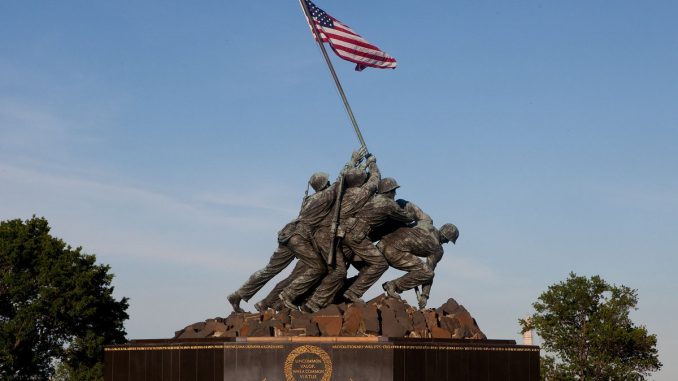
On This Day, February 23rd, 1945 – During the bloody Battle for Iwo Jima, U.S. Marines from the 3rd Platoon, E Company, 2nd Battalion, 28th Regiment of the 5th Division take the crest of Mount Suribachi, the island’s highest peak and most strategic position, and raise the U.S. flag. Marine photographer Louis Lowery was with them and recorded the event. American soldiers fighting for control of Suribachi’s slopes cheered the raising of the flag, and several hours later more Marines headed up to the crest with a larger flag. Joe Rosenthal, a photographer with the Associated Press, met them along the way and recorded the raising of the second flag along with a Marine still photographer and a motion-picture cameraman.
Rosenthal took three photographs atop Suribachi. The first, which showed five Marines and one Navy corpsman struggling to hoist the heavy flag pole, became the most reproduced photograph in history and won him a Pulitzer Prize. The accompanying motion-picture footage attests to the fact that the picture was not posed. Of the other two photos, the second was similar to the first but less affecting, and the third was a group picture of 18 soldiers smiling and waving for the camera. Many of these men, including three of the six soldiers seen raising the flag in the famous Rosenthal photo, were killed before the conclusion of the Battle for Iwo Jima in late March.
In early 1945, U.S. military command sought to gain control of the island of Iwo Jima in advance of the projected aerial campaign against the Japanese home islands. Iwo Jima, a tiny volcanic island located in the Pacific about 700 miles southeast of Japan, was to be a base for fighter aircraft and an emergency-landing site for bombers. On February 19, 1945, after three days of heavy naval and aerial bombardment, the first wave of U.S. Marines stormed onto Iwo Jima’s inhospitable shores.
The Japanese garrison on the island numbered 22,000 heavily entrenched men. Their commander, General Tadamichi Kuribayashi, had been expecting an Allied invasion for months and used the time wisely to construct an intricate and deadly system of underground tunnels, fortifications, and artillery that withstood the initial Allied bombardment. By the evening of the first day, despite incessant mortar fire, 30,000 U.S. Marines commanded by General Holland Smith managed to establish a solid beachhead.
During the next few days, the Marines advanced inch by inch under heavy fire from Japanese artillery and suffered suicidal charges from the Japanese infantry. Many of the Japanese defenders were never seen and remained underground manning artillery until they were blown apart by a grenade or rocket, or incinerated by a flame thrower.
While Japanese kamikaze flyers slammed into the Allied naval fleet around Iwo Jima, the Marines on the island continued their bloody advance across the island, responding to Kuribayashi’s lethal defenses with remarkable endurance. On February 23, the crest of 550-foot Mount Suribachi was taken, and the next day the slopes of the extinct volcano were secured.
By March 3, U.S. forces controlled all three airfields on the island, and on March 26 the last Japanese defenders on Iwo Jima were wiped out. Only 200 of the original 22,000 Japanese defenders were captured alive. More than 6,000 Americans died taking Iwo Jima, and some 17,000 were wounded.


God Bless the Marines!